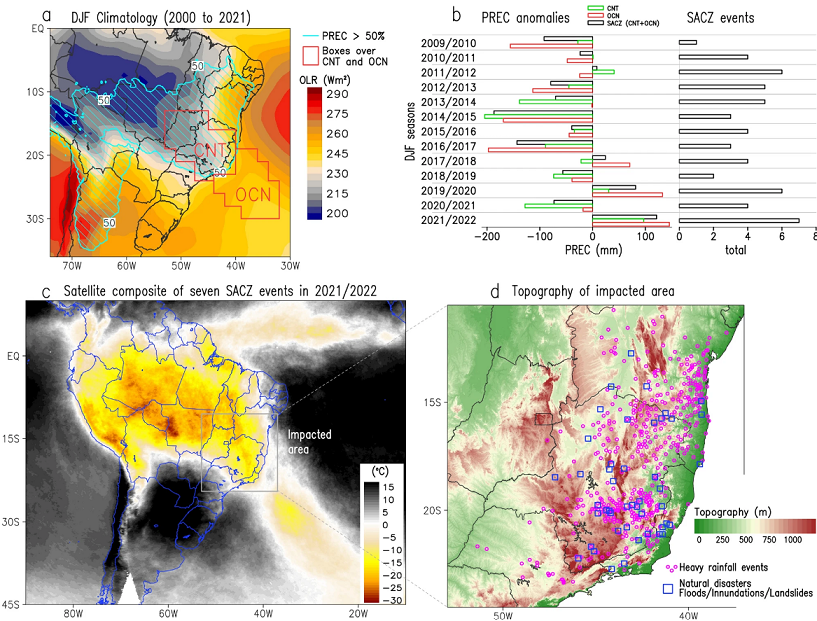Oceanic SACZ produces an abnormally wet 2021/2022 rainy season in South America

Figure 1 (a) December, January, and February (DJF) climatology for the period from 2000 to 2021 of Outgoing Longwave Radiation (OLR) shaded (W m−2) and percentage of precipitation (PREC) blue hatched (contours, %) emphasizing areas containing more than 50% of the annual total. (b) Time-series of box-averaged OLR, PREC anomalies over the continent (CNT), the ocean (OCN), and the whole SACZ area (CNT + OCN), and the total number of SACZ events (according to Rosa et al.8) during each DJF season. (c) Cloud top brightness temperature (°C) composite for the seven oceanic SACZ events in DJF 2021/2022. (d) Topography (shaded in m). The CNT and OCN areas are indicated in (a) as polygons in red lines. Symbols in (d) display heavy rainfall (purple circles) and natural disasters (blue squares) resulting from inundations, flash floods, and landslides. Grid Analysis and Display System (GrADS), Version 2.2.1.oga.1. http://opengrads.org
Researchers from the Ocean and Atmosphere Studies Laboratory (LOA), National Institute for Space Research (INPE) and collaborators, published the article “Oceanic SACZ produces an abnormally wet 2021/2022 rainy season in South America”, in Scientific Reports. Below is a summary in the lead author's own words, Dr. Luciano Pezzi:
“This article is a diagnosis of what Brazilian southeast rainy season was like last year 2021/22. We had "7 cases of South Atlantic Convergence Zone (SACZ)", which is an anomalous high number, and besides, all of them were Oceanic SACZ, even more anomalous. Because it is always a mix of Continental and Oceanic SACZ. In addition, we make dynamic and thermodynamic diagnosis of cases. The work is based on satellite data, coupled ocean-atmosphere regional modeling. These cases of oceanic SACZ were also analyzed from the perspective of Atmospheric Rivers (AR), which connect the moisture coming from the Amazon with the moisture found over the Southwest Atlantic. An additional and novelty was also the presence of our meteoceanographic buoy Criosfera-1 which was being tested, off shore, near Rio de Janeiro. For the first time, something about Marine Atmospheric Boundary Layer (MABL) stability processes has been analyzed with high quality in situ observed ocean and atmospheric data. These data shown that even as the ocean surface cools under Oceanic SACZ presence, it still gets warmer than the overlying air. The surface ocean even being coldes, it is still a source of heat for the atmosphere."
submitted by Luciano Pezzi
The full article can be accessed at: https://www.nature.com/articles/s41598-023-28803-w
-------------------------------------------------------------------------------------------------------------
Pezzi, L.P., Quadro, M.F.L., Souza, E.B. et al. Oceanic SACZ produces an abnormally wet 2021/2022 rainy season in South America. Sci Rep 13, 1455 (2023). https://doi.org/10.1038/s41598-023-28803-w














Add new comment